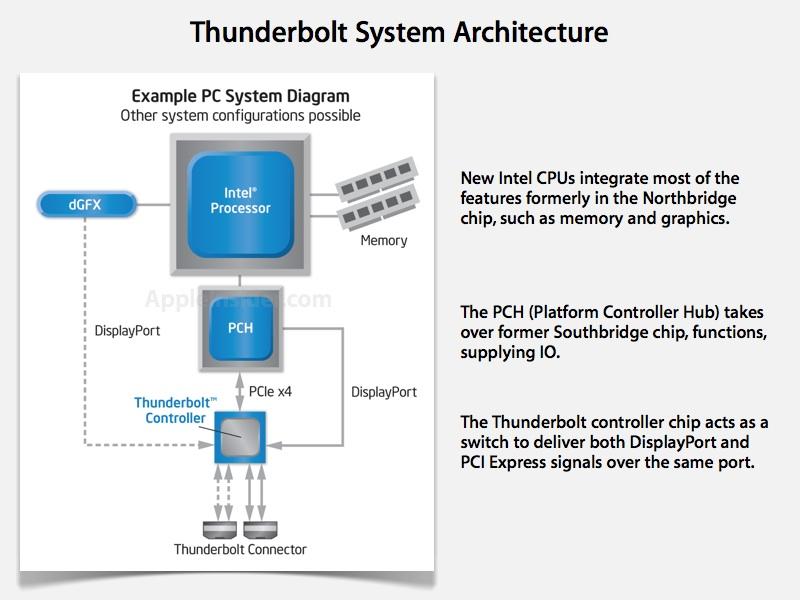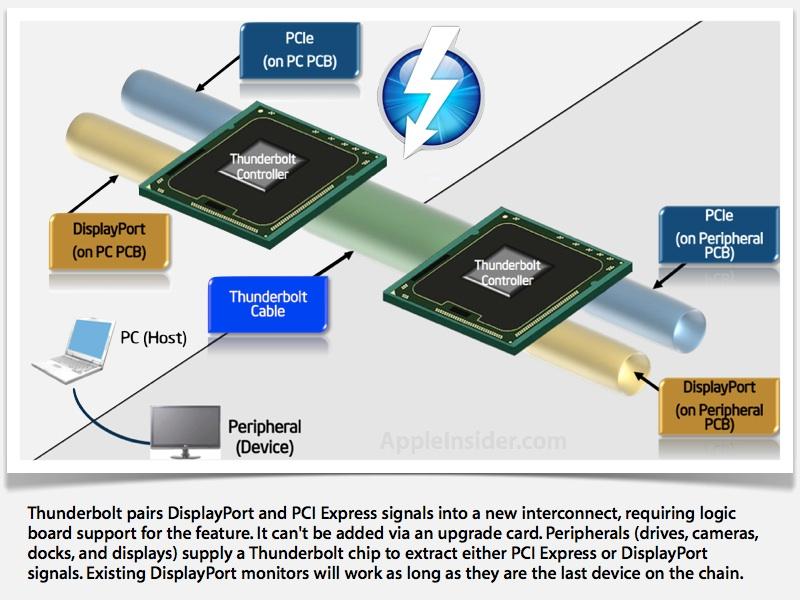Intel details Thunderbolt, says Apple has full year head start
As described in the First Look, the new specification pairs PCI Express with DisplayPort signaling in a collaboration with Apple. The PCI Express protocol was used because it's flexible and widely compatible with various types of I/O devices.
"You can extend the backbone of your computer to distributed devices that are connected to it," Intel representatives said, "and to the OS it looks like they're connected to the computer."
Based on work to develop an ultrafast new optical port originally named Light Peak, Intel's efforts to make the new low latency ("8 nanosecond accuracy time sync across 7 devices" for very little delay between operations), low overhead (hits much closer to the theoretical max than previous port specifications because of less background chat), high speed signaling standard was initially held back by the higher cost of optical cabling.
To reduce the cost, Intel collaborated with Apple to pair the technology with DisplayPort to deliver a single copper connection that was high performance and yet still economical.
By pairing the new interconnect with Mini DisplayPort (which Apple developed but has openly released as part of the DisplayPort specification), Thunderbolt should also help drive adoption of the Mini DisplayPort connector as well, which so far has largely been limited to Apple's own equipment. Other DisplayPort monitors from companies like Dell use a "full sized" connector that looks similar to USB, but which serves no value other than being larger.
The new standard is not backwardly compatible with USB 3.0, and Thunderbolt ports can't be added to existing PCs via an expansion card; Intel says the only way to have it is to buy a system or logic board that incorporates the new Thunderbolt controller chip. That's because the Thunderbolt chip needs direct access to both the system's video and PCI Express architecture.
PC makers are expected to begin adding Thunderbolt to their machines next spring, giving Apple a year to trailblaze the technology among high end users before it trickles down into the mainstream. Apple has partnered with Intel in the past to debut its new CPUs on Macs for a brief period, while the debut of DisplayPort (which is not an Intel standard) took a longer period to roll out.
PC makers and Microsoft were both slow to provide initial, enthusiastic support for USB, leaving it to Apple to kick-start widespread adoption. They rolled out USB 2.0 faster than Apple, and many now support USB 3.0 and eSATA, neither of which Apple has included on its machines.
Third party support
Thunderbolt supports two channels of 10Gbps (equivalent to about 1280MBps) transfers in both directions, simultaneously. Intel demonstrated actual throughputs of up to 6.25Gbps (800MBps) using prototype consumer products. There's very little overhead, Intel notes, compared to USB 3.0, which promises 5Gbps but can only possibly deliver throughput of about 3Gbps.
Very fast SATA interfaces are limited to 6Gbps, meaning Thunderbolt is currently much faster than most consumer devices you could attach to it, indicating the actual throughputs are likely running into the limits of SATA rather than reflecting the overhead of Thunderbolt itself.
Intel demonstrated Thunderbolt's daisy-chain feature attaching a MacBook Pro to a fast RAID, which then connected to a standard DisplayPort 1.1 monitor, performing high speed data transfers of multiple 1080p videos from a prototype Promise RAID device while delivering very high resolution 2K video to the display over the same cable.
Existing displays will work as long as they are the last device in the chain (because they don't have additional daisy-chain ports, and because they don't know how to pass through Thunderbolt if they did), so new monitors are not required. Hard drives and even video cameras are expected to supply two ports to enable chaining devices together like this.
Existing electrical copper cables can carry Thunderbolt signals for about 3 meters (about 10 feet) between devices, and carry 10 watts of power. In the future, fiber optic cables will be available to extend signals to "tens of meters." A purely optical cable won't deliver electrical power. Intel describes Thunderbolt as "a symmetric architecture that supports flexible topologies (star, tree, daisy chaining, etc.) and enables peer-to-peer communication (via software) between devices."
Third party support
The new port is already being supported by disk makers Promise and LaCie, with a voice of support from Western Digital (although not any products yet). Among media device makers, Aja, Apogee, Avid, Blackmagic, and Universal Audio have all announced support as well.
LaCie demonstrated a "Little Big Disk" RAID device built using two Intel SSD drive configured into a RAID 0 stripe set. The drive (or multiple units) is capable of being powered by the Thunderbolt bus as well, reducing the need for additional power bricks. LaCie hasn't yet released a price or availability date for the new drive.
The company described Thunderbolt as allowing a notebook system to interface via a desktop workstation system via Thunderbolt, and then share all of the desktop's ports with the connected machine via the Thunderbolt interconnect. This will allow "thinner and lighter laptops, expandable through Thunderbolt technology and its miniature connector designed for mobile applications, without sacrificing I/O performance."
Docking stations were also listed among the potential applications for the new interconnect, with Intel noting that Thunderbolt can "extend to reach other I/O technologies by using adapters that use widely available PCI Express controllers. It's simple to create a Gigabit Ethernet, or FireWire, or eSATA adapters using existing device PCI Express drivers."
 Daniel Eran Dilger
Daniel Eran Dilger












 Mike Wuerthele
Mike Wuerthele
 Malcolm Owen
Malcolm Owen
 Chip Loder
Chip Loder

 William Gallagher
William Gallagher
 Christine McKee
Christine McKee
 Michael Stroup
Michael Stroup
 William Gallagher and Mike Wuerthele
William Gallagher and Mike Wuerthele






